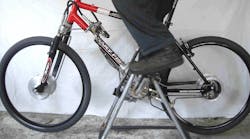What started out as Parker Hannifin’s Chainless Challenge has evolved into the NFPA Vehicle Challenge. Back in 2006, Parker Hannifin conducted the first Chainless Challenge, which was (and still is) a friendly competition among colleges and universities to design, construct, and operate a vehicle using hydraulics or pneumatics to transmit power from a human to the wheels.
As in the first Chainless Challenge, vehicles used in NFPA’s Vehicle Challenge are either a bicycle or a three-wheel recumbent bike. I think pneumatics was attempted once or twice, but all other entries have used hydraulics, sometimes with an accumulator to supplement human power. I’ve attended a few of these events and even served as a judge. After watching one of the competitions, I learned that just being able to finish the race is an accomplishment. Building a human-powered vehicle powered by hydraulics is much more difficult than I ever imagined.
The vehicles themselves are designed for function rather than form. They are generally bulky because they have to be made from components designed for industrial equipment rather than a bicycle. In fact, the pump is probably the most over-engineered component. That’s because pumps are designed to be driven at 1,800 or 3,600 rpm, whereas an athletic person could probably maintain only about 100 rpm for an extended period.
I remember one group of students explain that they used a power-steering pump because it could operate at lower speeds than any industrial hydraulic pump they found. The low-speed input means most vehicles use a gearbox to increase rotational speed of the pedal crank. The gearbox, of course, adds weight and bulk to the vehicle and reduces efficiency.
The bicycle shown here is different because it doesn’t look like a hardware store built around a bike. Dubbed the Hydrostatic Bicycle by Nahum Goldenberg, of Or Yehuda, Israel, this vehicle sounds like it can take full advantage of the versatility of hydraulics. It is powered by a variable-displacement, radial-piston pump, which has an infinitely variable speed-ratio control in automatic or manual mode. A fixed-displacement motor in the hub of each wheel can provide front-wheel drive, rear-wheel drive, or both.
I first met Nahum more than 20 years ago, after he had developed HydroCAD software for designing hydraulic circuits. I’ve met with him several times since then and have learned of his ongoing projects. The Hydrostatic Bicycle is one of them. You can’t buy this vehicle anywhere because it is still in the prototype stage undergoing R&D. And although most of us don’t have enough expendable cash to help invest in this technology, it’s an interesting and thought-provoking discussion to have with your fluid power peers.
If you’re interested in seeing the Hydrostatic Bicycle in action, view a YouTube video at bit.ly/HP1910Bike. And if you’re really interested, shoot Nahum an e-mail at [email protected].


